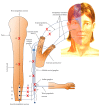Idiopathic Harlequin Syndrome Manifesting during Exercise: A Case Report and Review of the Literature
- PMID: 28316628
- PMCID: PMC5339527
- DOI: 10.1155/2017/5342593
Idiopathic Harlequin Syndrome Manifesting during Exercise: A Case Report and Review of the Literature
Abstract
Harlequin syndrome is a rare autonomic disorder characterized by unilateral facial flushing and sweating with contralateral anhidrosis induced by exercise, heat, and emotion. It is usually idiopathic but could be the first manifestation of several serious underlying medical conditions. Medical or surgical treatments are not required for idiopathic Harlequin syndrome, but social and psychological factors may indicate sympathectomy or botulinum toxin injection. In this article, we report a case of idiopathic Harlequin syndrome and review the literature.
Conflict of interest statement
The authors declare that they have no conflict of interests.
Figures

References
Publication types
LinkOut - more resources
Full Text Sources
Other Literature Sources

